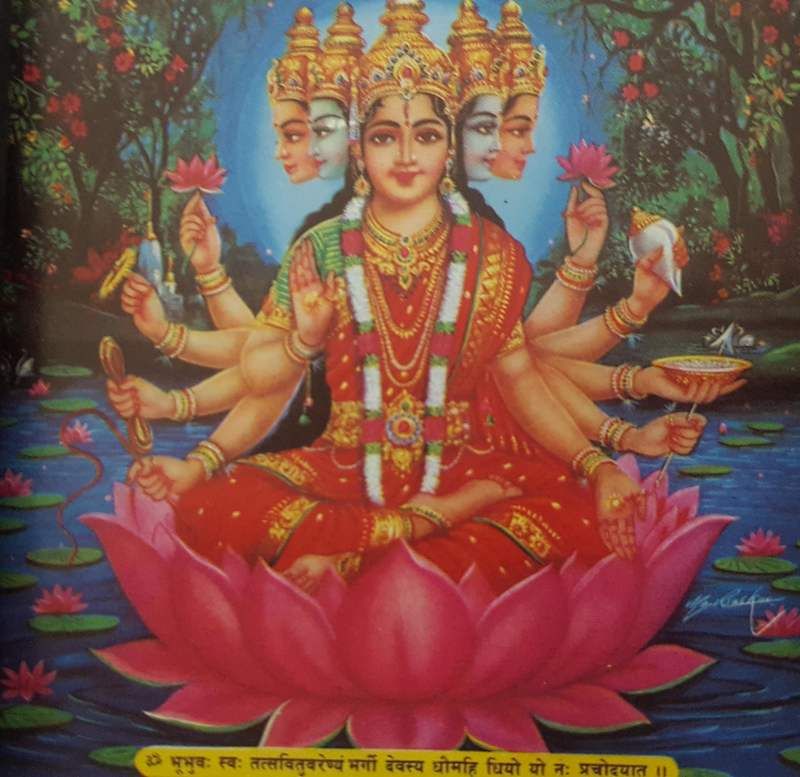|
We all have heard the power of words. Singing of Deepak Raag, fires the lamps and singing Raag Malhar, raining starts. The various sound of music alleviates the chronic diseases. Chanting of mantras creates vibrations in atoms of body and powerful energy. The Gayatri mantra is considered crown in all Hindu mantras and being very potent in invoking the universal Brahman. The mantra is extracted from the 10th verse of Hymn 62 in Book III of the Rig Veda. The glory of the mantra is mentioned in all Vedas and other Hindu scriptures. It has been praised by various rishis and Acharya. Dr.Howard Steingeril, an American scientist, tested the strength of Mantras, Hymns and invocations of all over the world. Gayatri Mantra produced 110,000 sound waves /second. This was the highest and was found to be the most powerful hymn in the world. The Gayatri mantra is as under: ॐ भूर्भुवस्व: | तत्सवितुर्वरेण्यम् | भर्गो देवस्य धीमहि | धियो यो न: प्रचोदयात् Om Bhurbhuvaswaha Tatsaviturvarenyam bhargo devasya dhimahi dhiyo yo naha prachodayat, Gayatri sadhana brings physical, mental and spiritual happiness and helps in realization of cosmic consciousness (almighty). Gayatri Mantra inspires the mind for satvik actions. It has 24 syllables which activates 24 glands of body (details given in coming paras). Yagyopaveet or upanayan (Sacred Thread Ceremony) Sanskar and commencement of study of Vedas, are started with Gayatri Mantra. Gayatri mata is shown with five faces and ten hands. Five faces symbolizes five deities (Aum, Ganesha, Vishnu, Shiva & Bhavani), five elements of life (Earth, Water, Air, Akash & Fire), five sheaths of living being (Annmaya, Pranamaya, Manomaya, Vijyanmaya & Anandamaya), five senses (see, hear, smell, touch & taste), five organs of action (powers of speech, handling, movement, excretion and procreation or reproduction) and five internal instruments (Soul, Ego, Intellect, Mind & Chit). Ten hands destroy corrupt eyes, dependency, triviality, fear, negligence, selfishness, indecision, passion, greed and laziness. The details of Gayatri Mantra such as its meanings, genesis and significance are given hereunder:-
1 Comment
ॐ – The AUM Mantra
Om or AUM is the most important sound, syllable, symbol which has great spiritual significance not only in Hinduism but also in most religions of the world. AUM is manifesting word of God. AUM is the energy which harmonise our body, mind and soul and connects with Cosmic Consciousness. From Aum universe projects and into Aum it is again withdrawn. Aum is the mother of all names and forms. In Aum the whole universe, from the minutest atom to the perfect man lives, moves and has its being. Aum is the central secret and the concealed essence of everything, being the background of oneness behind the passing manifoldness. It is the center on which rests the involution and evolution, owing to its omnipresent nature. It is truth eternal, knowledge divine and essence everlasting. It is the Self of everything. AUM represents the whole sound producing system in the mouth which starts from abdomen to heart to head and ultimately connects to cosmic consciousness. Om is the single most important sound that can, by itself, configure the human body optimally for maximum resonance. The essence and importance of AUM finds mention in various Upanishads and other religious texts of Hinduism. It is a sacred spiritual invocation made before and during the recitation of spiritual texts, during puja, ceremonies of rites of samskara, Meditation and Yoga. It is first syllable to initiate most mantras. The sound and structure of AUM describes four states of consciousness viz. conscious state, active unconscious state, latent unconscious state and pure conscious state which operates through seven instruments & nineteen channels. The three root syllables of AUM represent three deities, three genders, three Vedas, etc. OM is sacred in Jainism, & Buddhism, as Omkar in Sikhism, Hum in Tibetans, Ameen in Muslims, Amen in Egyptians, Greeks, Romans, Jews, and Christians. In a pilot functional Magnetic Resonance Imaging study, the neurohemodynamic correlates of ‘OM’ chanting indicate limbic deactivation. Similar observations have been recorded with vagus nerve stimulation treatment used in depression and epilepsy, the study findings argue for a potential role of this ‘OM’ chanting in clinical practice. The explanations of AUM, its science, details as per various scriptures of Hinduism and its relevance in other religions are as under: - Science of AUM AUM is the basis of all sounds. The first letter, A, is the root sound rises from the belly, lips are parted, pronounced without touching any part of the tongue or palate; the U sound moves from the abdomen into the heart & rolls from the very root to the end of the sounding board of the mouth and the M represents the last sound in the series, being produced by the closed lips which creates a buzzing in the head. Fourth sound fades into nothing. Thus, Om represents the whole phenomena of sound-producing. AUM in Hinduism In Hinduism, AUM is cosmic sound. Various Upanishads have explained the spiritual concept and divinity of AUM.
Raja, Jnana, Karma, and Bhakti Yoga, as well as Kriya, Kundalini, Mantra, Nada, Siddha, and Tantra Yoga etc. finally converge into a unified force directed towards the final stage, piercing the pearl of wisdom called bindu, leading to the Absolute.
AUM & other Religions
Reference:
|
Archives
July 2024
Categories |

 RSS Feed
RSS Feed